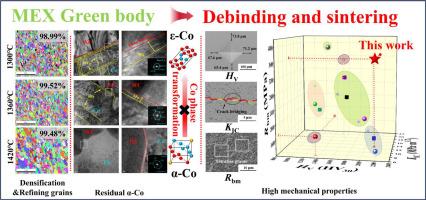Achieving high mechanical properties of ultrafine-grained WC-Co cemented carbide via material extrusion additive manufacturing
IF 14.3
1区 材料科学
Q1 MATERIALS SCIENCE, MULTIDISCIPLINARY
引用次数: 0
Abstract
The urgent demand for additive manufacturing (AM) cemented carbide parts with complex geometric structures has emerged. However, the powder bed fusion AM WC-Co cemented carbide exhibits poor mechanical properties due to cracks, pores, and abnormal WC grain growth caused by low formability, particularly ultrafine-grained cemented carbide. We employed material extrusion (MEX) AM to prepare an ultrafine-grained WC-0.5Cr3C2-0.2CeO2-9Co cemented carbide. MEX AM eliminated defects, inhibited the abnormal WC grain growth, and increased the residual α-Co content at room temperature by improving the W and C solubility in α-Co to increase the stacking fault energy. The cemented carbide achieved a relative density of 99.52%, as well as α-Co content, an average grain size of WC, the adjacency of the WC phase, and the mean free path of the Co phase were measured at 16.5 vol.%, 384.6 nm, 0.58, and 208 nm, respectively. The synergistic effects of densification reinforcement, fine grain strengthening, and residual α-Co phase toughening, simultaneously improved the mechanical properties of the cemented carbide, achieving a Vickers hardness of 2123 ± 11 HV30, a transverse rupture strength of 3639 ± 28 MPa, and a fracture toughness of 13.13 ± 0.03 MPa m1/2, respectively, which demonstrated significantly superior mechanical properties compared with cemented carbide prepared via AM or traditional powder metallurgy. These findings effectively address the challenge of simultaneously enhancing the hardness and fracture toughness of ultrafine-grained cemented carbide and provide important guidance for the development of cemented carbide with excellent mechanical properties via AM.

采用材料挤压增材制造技术制备了高力学性能的超细晶WC-Co硬质合金
对复杂几何结构的增材制造硬质合金零件的迫切需求已经显现。然而,粉末床熔合AM WC- co硬质合金的力学性能较差,主要是由于低成形性导致的裂纹、气孔和WC晶粒生长异常,尤其是超细晶硬质合金。采用材料挤压(MEX) AM法制备超细晶WC-0.5Cr3C2-0.2CeO2-9Co硬质合金。MEX AM通过改善W和C在α-Co中的溶解度,提高层错能,消除了缺陷,抑制了WC晶粒的异常长大,提高了室温下残余α-Co含量。合金的相对密度为99.52%,α-Co含量为16.5 vol.%, WC的平均晶粒尺寸为384.6 nm, WC相的邻接度为0.58 nm, Co相的平均自由程为208 nm。致密化强化、细晶强化和残余α-Co相增韧的协同作用同时提高了硬质合金的力学性能,其维氏硬度为2123±11 HV30,横向断裂强度为3639±28 MPa,断裂韧性为13.13±0.03 MPa m1/2,与AM或传统粉末冶金制备的硬质合金相比,力学性能明显优越。这些研究结果有效地解决了同时提高超细晶硬质合金硬度和断裂韧性的难题,为通过增材制造开发具有优异力学性能的硬质合金提供了重要的指导。
本文章由计算机程序翻译,如有差异,请以英文原文为准。
求助全文
约1分钟内获得全文
求助全文
来源期刊

Journal of Materials Science & Technology
工程技术-材料科学:综合
CiteScore
20.00
自引率
11.00%
发文量
995
审稿时长
13 days
期刊介绍:
Journal of Materials Science & Technology strives to promote global collaboration in the field of materials science and technology. It primarily publishes original research papers, invited review articles, letters, research notes, and summaries of scientific achievements. The journal covers a wide range of materials science and technology topics, including metallic materials, inorganic nonmetallic materials, and composite materials.
 求助内容:
求助内容: 应助结果提醒方式:
应助结果提醒方式:


